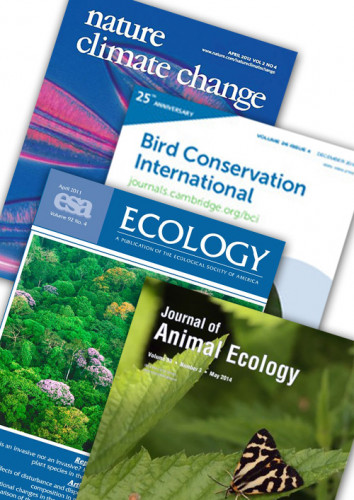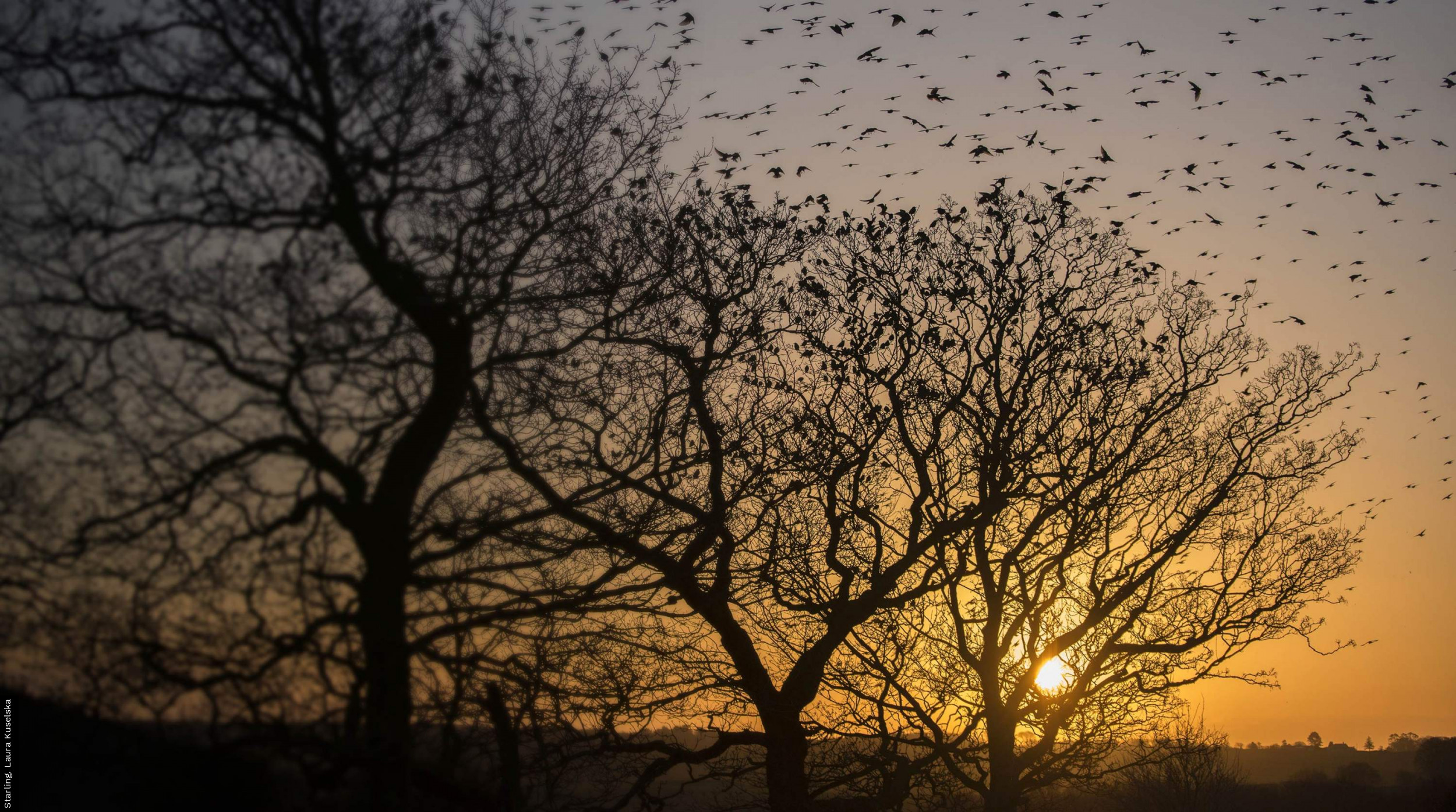Peer-reviewed papers

It is BTO’s policy to make public the results of our research. Our aim is to publish as much as possible of our work in the peer reviewed scientific literature. Many results are also published in our BTO Research Report series.
2021.
New estimates of the size and trend of the world population of the Spoon-billed Sandpiper using three independent statistical models.
Wader Study
128
Link to Article (DOI: 10.18194/ws.00218)
2021.
Latitudinal variation in arrival and breeding phenology of the pied flycatcher Ficedula hypoleuca using large-scale citizen science data.
Journal of Avian Biology
Link to Article (DOI: 10.1111/jav.02646)
2021.
Spatial patterns of weed dispersal by wintering gulls within and beyond an agricultural landscape.
Journal of Ecology
Link to Article (DOI: 10.1111/1365-2745.13619)
2021.
Contrasting long‐term trends in age‐specific survival of Peregrine Falcons (Falco peregrinus) in Britain using smoothed estimates of recovery probabilities.
Ibis
Link to Article (DOI: 10.1111/ibi.12943)
2021.
Rewilding and intervention: complementary philosophies for nature conservation in Britain.
British Wildlife
32
: 258-267
View Abstract
2021.
Long‐distance migrants vary migratory behaviour as much as short‐distance migrants: an individual‐level comparison from a seabird species with diverse migration strategies.
Journal of Animal Ecology
Link to Article (DOI: 10.1111/1365-2656.13431)
2021.
Carryover effects of long-distance avian migration are weaker than effects of breeding environment in a partially migratory bird.
Scientific Reports
11
Link to Article (DOI: 10.1038/s41598-020-80341-x)
2021.
Methods to quantify avian airspace use in relation to wind energy development.
Ibis
Link to Article (DOI: 10.1111/ibi.12913)
2021.
A counterfactual approach to measure the impact of wet grassland conservation on UK breeding bird populations.
Conservation Biology
Link to Article (DOI: 10.1111/cobi.13692)
2021.
A global horizon scan of the future impacts of robotics and autonomous systems on urban ecosystems.
Nature Ecology & Evolution
Link to Article (DOI: 10.1038/s41559-020-01358-z)
2020.
The acoustic identification of small terrestrial mammals in Britain.
British Wildlife
32
: 186-194
View Abstract
2020.
Strengthening the evidence base for temperature-mediated phenological asynchrony and its impacts.
Nature Ecology & Evolution
Link to Article (DOI: 10.1038/s41559-020-01357-0)
2020.
Delivering robust population trends for Scotland's widespread breeding birds.
Scottish Birds
40 (part 4)
: 297-304
2020.
Effectiveness of the European Natura 2000 network to sustain a specialist wintering waterbird population in the face of climate change.
Scientific Reports
10
Link to Article (DOI: 10.1038/s41598-020-77153-4)
2020.
Irregular silviculture positively influences multiple bat species in a lowland temperate broadleaf woodland.
Forest Ecology and Management
Link to Article (DOI: 10.1016/j.foreco.2020.118786)
2020.
A 2021 Horizon Scan of Emerging Global Biological Conservation Issues.
Trends in Ecology and Evolution
Link to Article (DOI: 10.1016/j.tree.2020.10.014)
2020.
Evaluating spatially explicit sharing‐sparing scenarios for multiple environmental outcomes.
Journal of Applied Ecology
Link to Article (DOI: 10.1111/1365-2664.13785)
2020.
Camera traps reveal predators of breeding Black Guillemots Cepphus grylle.
Seabird
32
: 72-83
View Abstract
2020.
Individual variability and versatility in an eco-evolutionary model of avian migration.
Proceedings of the Royal Society B
Link to Article (DOI: 10.1098/rspb.2020.1339)
2020.
Electrical Components Involved in Avian-Caused Outages in Iran.
Bird Conservation International
Link to Article (DOI: 10.1017/S0959270920000507)
2020.
DNA diet profiles with high‐resolution animal tracking data reveal levels of prey selection relative to habitat choice in a crepuscular insectivorous bird.
Ecology and Evolution
Link to Article (DOI: 10.1002/ece3.6893)
2020.
Pollinator monitoring more than pays for itself.
Journal of Applied Ecology
Link to Article (DOI: 10.1111/1365-2664.13755)
2020.
Benefits of protected areas for nonbreeding waterbirds adjusting their distributions under climate warming.
Conservation Biology
35
: 834-845
Link to Article (DOI: 10.1111/cobi.13648)
2020.
Using citizen science to assess drivers of Common House Martin breeding performance.
Ibis
Link to Article (DOI: 10.1111/ibi.12888)
2020.
Phenological mismatch between breeding birds and their surveyors and implications for estimating population trends.
Journal of Ornithology
162
: 143-154
Link to Article (DOI: 10.1007/s10336-020-01821-5)
2020.
Evolution of chain migration in an aerial insectivorous bird, the Common Swift Apus apus.
Evolution
Link to Article (DOI: 10.1111/evo.14093)
2020.
Behavioural responses of non-breeding waterbirds to drone approach are associated with flock size and habitat.
Bird Study
Link to Article (DOI: 10.1080/00063657.2020.1808587)
2020.
Investigating the implications of shifting baseline syndrome on conservation.
People and Nature
Link to Article (DOI: 10.1002/pan3.10140)
2020.
Do surveys of adult dragonflies and damselflies yield repeatable data? Variation in monthly counts of abundance and species richness.
Journal of Insect Conservation
Link to Article (DOI: 10.1007/s10841-020-00260-0)
2020.
Disentangling the relative roles of climate and land cover change in driving the long‐term population trends of European migratory birds.
Diversity and Distributions
Link to Article (DOI: 10.1111/ddi.13144)
2020.
Ensuring tests of conservation interventions build on existing literature.
Conservation Biology
34
: 781-783
Link to Article (DOI: 10.1111/cobi.13555)
2020.
Can microclimate offer refuge to an upland bird species under climate change?.
Landscape Ecology
Link to Article (DOI: 10.1007%2Fs10980-020-01069-7)
2020.
Roads as a contributor to landscape-scale variation in bird communities.
Nature Communications
11
Link to Article (DOI: 10.1038/s41467-020-16899-x)
2020.
Evaluating the potential for bird‐habitat models to support biodiversity‐friendly urban planning.
Journal of Applied Ecology
57
: 1 902-1 914
Link to Article (DOI: 10.1111/1365-2664.13703)
2020.
Breeding bird communities within a parkland-woodland continuum: the distinctiveness of wood-pasture.
Arboricultural Journal
Link to Article (DOI: 10.1080/03071375.2020.1767965)
2020.
Livestock grazing impacts components of the breeding productivity of a common upland insectivorous passerine: Results from a long‐term experiment.
Journal of Applied Ecology
Link to Article (DOI: 10.1111/1365-2664.13647)
2020.
A schematic sampling protocol for contaminant monitoring in raptors.
Ambio
Link to Article (DOI: 10.1007/s13280-020-01341-9)
2020.
What motivates the masses: Understanding why people contribute to conservation citizen science projects.
Biological Conservation
246
Link to Article (DOI: 10.1016/j.biocon.2020.108587)
2020.
Aflatoxin and ochratoxin A residues in supplementary foods used for wild birds.
Science of The Total Environment
731
Link to Article (DOI: 10.1016/j.scitotenv.2020.138851)
2020.
Effect of GPS tagging on behaviour and marine distribution of breeding Arctic Terns Sterna paradisaea.
Ibis
Link to Article (DOI: 10.1111/ibi.12849)
2020.
Evidence for senescence in survival but not in reproduction in a short-lived passerine.
Ecology and Evolution
Link to Article (DOI: 10.1002/ece3.6281)
2020.
Survival varies seasonally in a migratory bird: linkages between breeding and non‐breeding periods.
Journal of Animal Ecology
Link to Article (DOI: 10.1111/1365-2656.13250)
2020.
Positive impacts of important bird and biodiversity areas on wintering waterbirds under changing temperatures throughout Europe and North Africa.
Biological Conservation
246
Link to Article (DOI: 10.1016/j.biocon.2020.108549)
2020.
Variation in abundances of common bird species associated with roads.
Journal of Applied Ecology
Link to Article (DOI: 10.1111/1365-2664.13614)
2020.
Survival of Eurasian Curlew Numenius arquata differs by season but not breeding origin.
Wader Study
127
: 25-30
Link to Article (DOI: 10.18194/ws.00176 )
2020.
Estimating species distributions from spatially biased citizen science data.
Ecological Modelling
422
Link to Article (DOI: 10.1016/j.ecolmodel.2019.108927)
2020.
Opening a can of worms: Can the availability of soil invertebrates be indicated by birds?.
Ecological Indicators
113
Link to Article (DOI: 10.1016/j.ecolind.2020.106222)
2020.
Integrating scientific and local knowledge to address conservation conflicts: Towards a practical framework based on lessons learned from a Scottish case study.
Environmental Science & Policy
107
: 46-55
Link to Article (DOI: 10.1016/j.envsci.2020.02.017)



Share this page